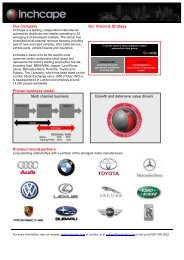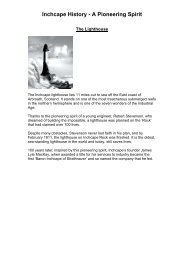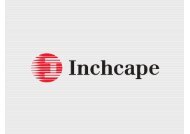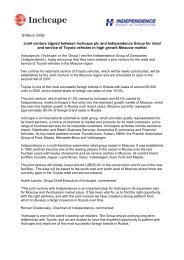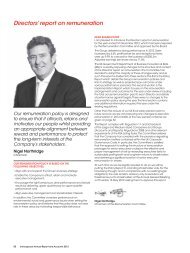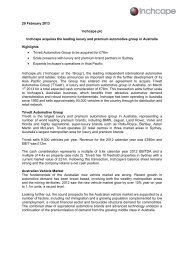Full Annual Report - Inchcape
Full Annual Report - Inchcape
Full Annual Report - Inchcape
Create successful ePaper yourself
Turn your PDF publications into a flip-book with our unique Google optimized e-Paper software.
Section<br />
Three<br />
Financial<br />
statements<br />
Share-based payments<br />
The Group operates various share-based award schemes. The fair value at the date at which the share-based awards are granted is<br />
recognised in the consolidated income statement (together with a corresponding increase in shareholders’ equity) on a straight line<br />
basis over the vesting period, based on an estimate of the number of shares that will eventually vest. For equity-settled share-based<br />
awards, the services received from employees are measured by reference to the fair value of the awards granted. With the exception<br />
of the Group ‘Save as you earn’ scheme, the vesting of all share-based awards under all schemes is solely reliant upon non-market<br />
conditions therefore no expense is recognised for awards that do not ultimately vest. Where an employee cancels a ‘Save as you earn’<br />
award, the charge for that award is recognised as an expense immediately, even though the award does not vest.<br />
Finance costs<br />
Borrowing costs which are directly attributable to the acquisition, construction or production of a qualifying asset are capitalised as part<br />
of the cost of that asset from the first date on which the expenditure is incurred for the asset and until such time as the asset is ready for<br />
its intended use. A Group capitalisation rate is used to determine the magnitude of borrowing costs capitalised on each qualifying<br />
asset. This rate is the weighted average of Group borrowing costs, excluding those borrowings made specifically for the purpose of<br />
obtaining a qualifying asset.<br />
All other borrowing costs are recognised as an expense in the period in which they are incurred.<br />
Income tax<br />
The charge for current income tax is based on the results for the period as adjusted for items which are not taxed or disallowed. It is<br />
calculated using tax rates that have been enacted or substantively enacted by the end of the reporting period.<br />
Deferred income tax is accounted for using the liability method in respect of temporary differences arising from differences between<br />
the tax bases of assets and liabilities and their carrying amounts in the consolidated Financial statements.<br />
In principle, deferred tax liabilities are recognised for all taxable temporary differences and deferred tax assets are recognised to the<br />
extent that it is probable that taxable profits will be available against which deductible temporary differences can be utilised. Such<br />
assets and liabilities are not recognised if the temporary difference is due to goodwill arising on a business combination, or to an<br />
asset or liability, the initial recognition of which does not affect either taxable or accounting income.<br />
Deferred tax liabilities are recognised for taxable temporary differences arising on investments in subsidiaries, joint ventures and<br />
associates, except where the Group is able to control the reversal of the temporary difference and it is probable that the temporary<br />
difference will not reverse in the foreseeable future.<br />
Deferred tax is calculated at the tax rates that are expected to apply to the period when the asset is realised or the liability is settled<br />
using rates enacted at the end of the reporting period. Deferred tax is charged or credited in the consolidated income statement,<br />
except when it relates to items credited or charged directly to shareholders’ equity, in which case the deferred tax is also dealt with in<br />
shareholders’ equity.<br />
Deferred tax assets and liabilities are only offset where there is a legally enforceable right of offset and there is an intention to settle<br />
balances net.<br />
Exceptional items<br />
Items which are both material and non-recurring are presented as exceptional items within their relevant consolidated income<br />
statement category. The separate reporting of exceptional items helps provide additional useful information regarding the Group’s<br />
underlying business performance. Examples of events which may give rise to the classification of items as exceptional include gains<br />
or losses on the disposal of businesses, restructuring of businesses, litigation, asset impairments and exceptional tax related matters.<br />
Goodwill<br />
Goodwill represents the excess of the cost of acquisition of a business combination over the Group’s share of the fair value of identifiable<br />
net assets of the business acquired at the date of acquisition. Goodwill is initially recognised at cost and is held in the currency of the<br />
acquired entity and revalued at the closing exchange rate at the end of each reporting period.<br />
After initial recognition, goodwill is measured at cost less any accumulated impairment losses. At the date of acquisition, the goodwill is<br />
allocated to cash generating units for the purpose of impairment testing and is tested at least annually for impairment.<br />
Gains and losses on disposal of a business include the carrying amount of goodwill relating to the business sold in determining the gain<br />
or loss on disposal, except for goodwill arising on business combinations on or before 31 December 1997 which has been deducted<br />
from shareholders’ equity and remains indefinitely in shareholders’ equity.<br />
www.inchcape.com 85






